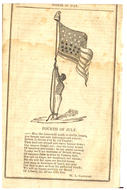American Anti-Slavery Almanac, 1844.
This verse on page 36 by William Lloyd Garrison, the editor of The American Anti-Slavery Almanac, drew early attention to the sectional strife within the nation well before the Civil War. Note the black and white stars on the stylized flag, denoting the northern and southern states as "free" and "slave" states. The slave is bound by the flag's halyard, out of reach of the liberty cap. This symbolic rendering of the national symbol demonstrates a country of contradictions. The idea that the flag itself was in conflict was not well understood today. It was thought that we had a national flag of unity right up to the time of the Civil war when in fact the flag was in conflict for 10 years before the succession of the Southern states from the Union. It was the abolitionist creation of this "other' flag an idea in fact that begin to focus our image of ourselves was not the national symbol the people idealized so long as the institution of slavery existed and even flourished in half the states.
We begin to see as early as 1850 the characture use of the flag to exclude the states of the South. In fact it is not clear it was the northern abolitionist began this war of the flag against itself. It was discovered by the late historian Howard Madaus work with the ZFC collection in the mid 1990's he coined the term "Inclusionary flag(s)" denoting the post contemporary 15 star flag the first star count to be used in the slavery debate which began during the period of the 30 star flag, pre 1851. The idea was that the South as a reaction to abolitionist use of symbols as we see in this political art with the black stars the idea the South was being excluded from the row call of support of the ideals of freedom, liberty, and other terms that express a new political system in the world order. The French followed our example in their bloody revolution with far greater violence than the American Revolution.
The South reacted by creating 15 Star flags that collectors started to discover years ago but there was no surviving record of what they stood for so they were misidentified as centennial or 50 year celebration by Kentucky the 15th state. This did not seem right to scholars and some collectors so there existed a suspicion something else was afoot. Madaus researched this matter for over 10 years and had scene enough of these to come to another conclusion. There was evidence such as but not only the caricature of the slave tied to the flag pole the use and meaning of post contemporary 15 star flags with evidence of materials found in the mid 19th century not the late 18th century that they definitely were not originals. This was confirmed when Madaus started looking at 16 star flags thought by some collectors and museum collections to be original to the period of 1796 to 1803 and found some not all showed evidence of early machine sewing and not hand sewn one would expect to see if they were originals. Some of the materials were definitely ear marked as mid 19th century origin and thus could not be original to the period of 16 star flags as well as the other star counts from 17 to 19 stars. The sewing machine was not in significant use until 1850 and beyond though it was invented in 1847/48. So Madaus suspected it was the 31 star flags were the answer and these were likely abolitionist flags who countered the Southern critics who used 15 star flags called "Inclusionary" flags because the Southern idea was they represented the 15 southern states as being more representative to the true ideals of the Revolution of 1775/76 than industrial northern states who the South saw as a threat to those ideals in the pursuit of money and power as well as the political power the South encompassed in Congress. They saw it was a matter of time that the South would be out voted in the federal chambers of the House and Senate as more northern and mid western states were admitted than southern and some western states which was a toss up as to their sympathies.
When 16 star flags began to appear at the time of 31 states the 15 slave or Southern states were being "excluded" from the canton by abolitionist of the union and it signaled the flag was at war with itself. That was 10 years before the first battle of the Civil War and it would continue with each new free state addition of a star to the canton till it ended with the 34/19 star flag at the beginning of the war. The 32nd star begat the 17 star "Exclusionary Flag, the 33 star begat the 18 star "Exclusionary" flag and the 34 star begat the 19 star "Exclusionary" flag. Howard Madaus work with the ZFC gave him the opportunity to examine samples of early original contemporary american flags to compare with the latter produced early star counts from 15 to 19 star counts that clearly were made later than their original periods, unless we believe in time travel.
Madaus began to acquire evidence with the Zaricor Flag Collection of the Inclusionary and Exclusionary Flags 15 star flags up to 19 star flags. The 19 star Exclusionary proving them contemporary with the 34 star flags which is just after the outbreak of the war. The 19th state, Indiana has been credited being the source of 19 star flags collectors find today but there is no evidence they were upon examination. Plus the 50 year celebration would be 1866 but we have provenance with many of those 19 star flags machine sewn with a Civil War attribution. Are they militia unit national flags? There is no evidence there was such a thing in regulations or official practice that 19 stars 13 stripes were adopted. There is evidence militia units in the Civil War carried 19 star flags to war and it is now believed they were abolitionist flags adopted by units or individuals in the first two years of the war took them to war as a symbolic gesture and this might have been repeated for 16 to 18 star flags made in the 1850s and used by militia units at the state level. We look back and see evidence like the pamphlet and find other similar materials of the Abolitionist Movement which more or less ended with the Civil War. and certainly by the time of the 35 star flags. Also, the US military had by the third and fourth year of that war had standardized their flags and unofficial flags of the militia were returned to the states or had been lost in the war Plus we find a trail of flags from 15 star counts to 19 star counts they either are contemporary to the late 18th and early 19th century or correspond to 34 star to 30 star flags less 15 stars equals to states.
Publication History
Schrambling, Regina, "A Lifelong Pledge." Collection, Published by Robb Report, June 2014, p. 48D.
Provenance
Acquired by purchase.




